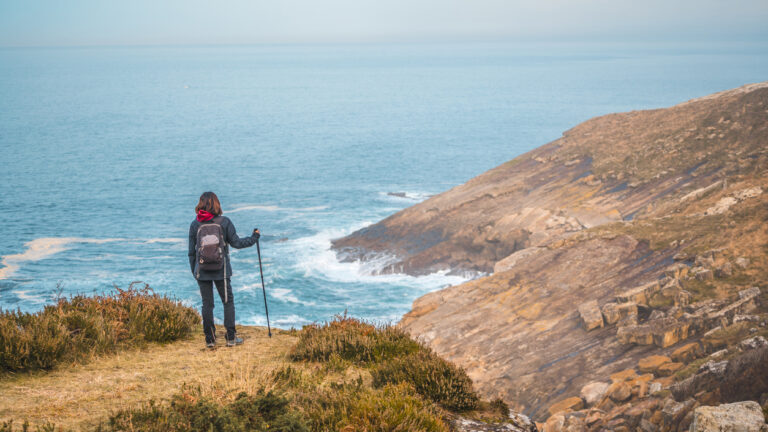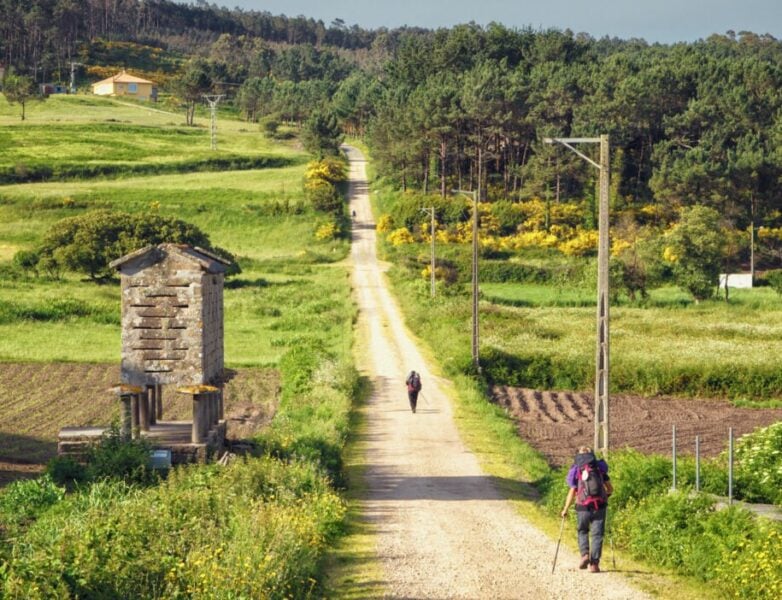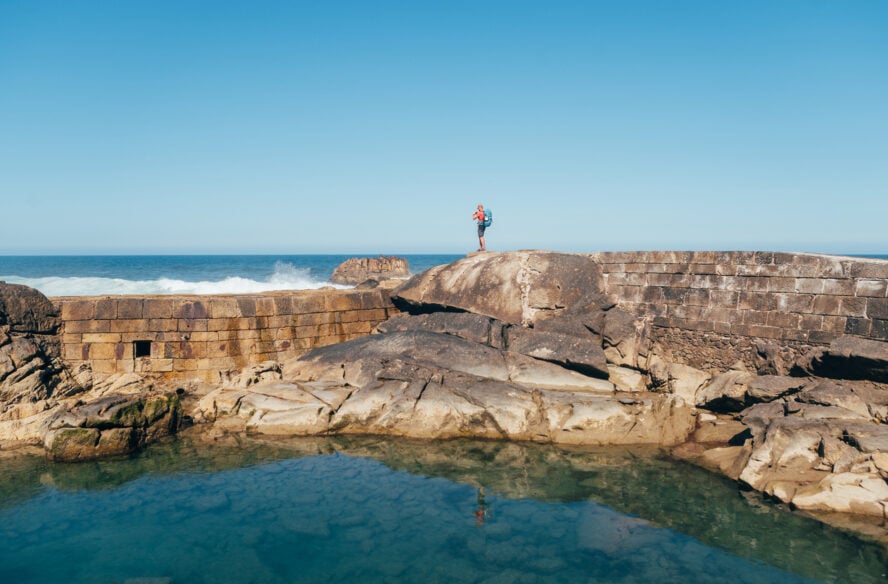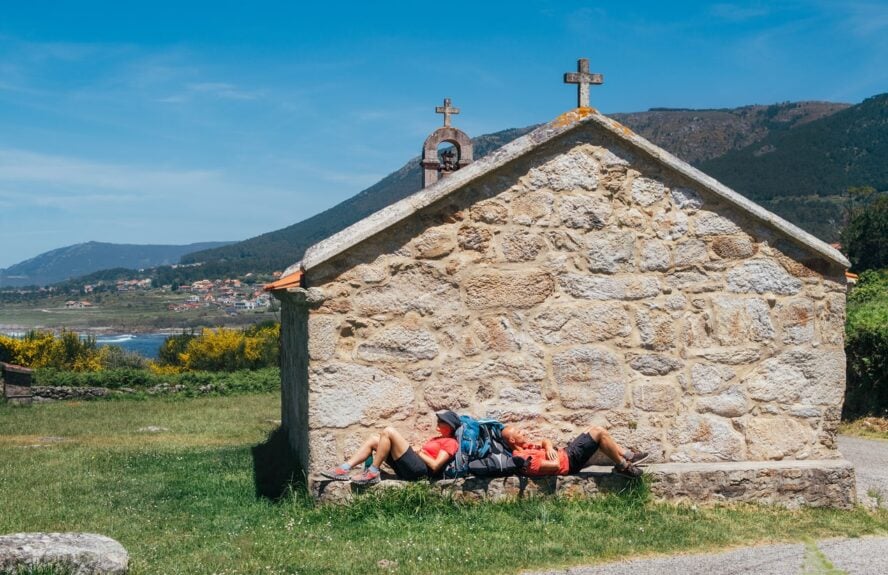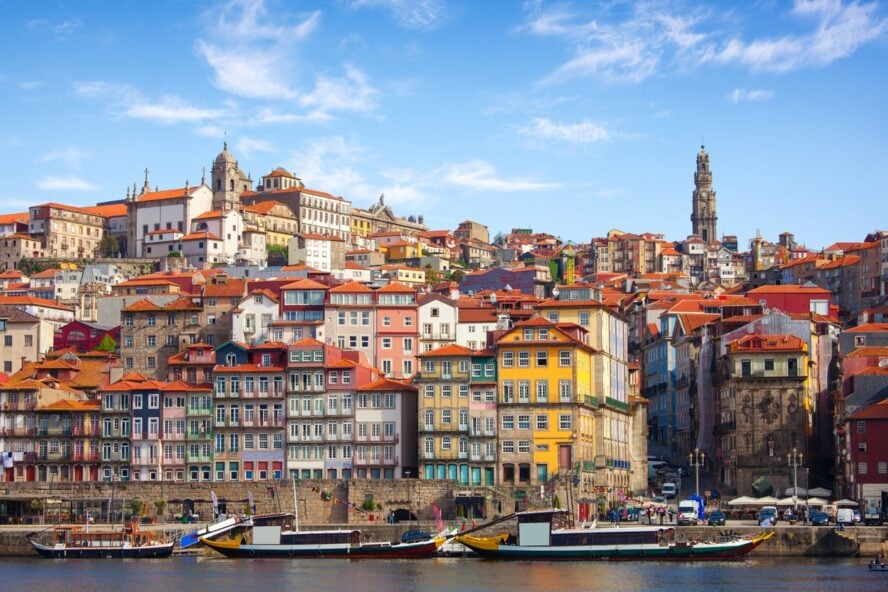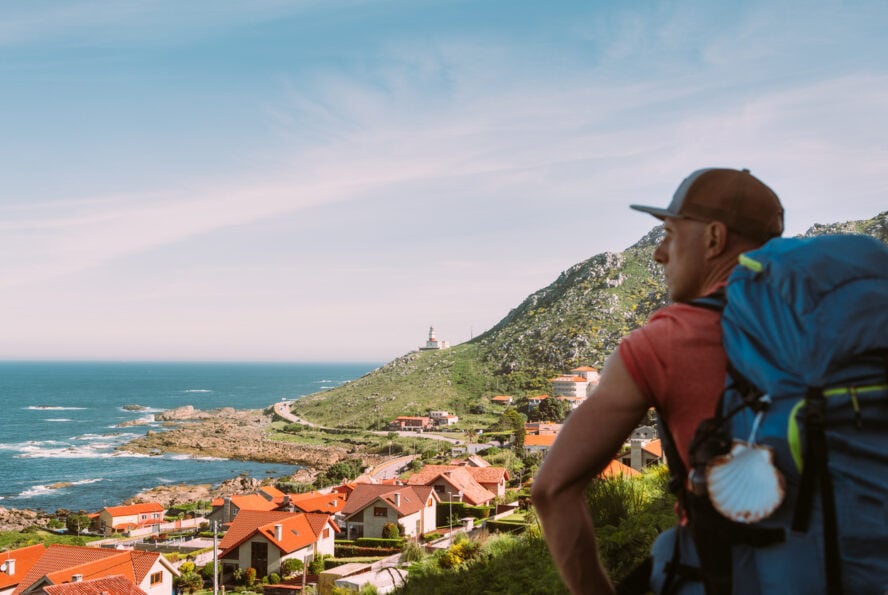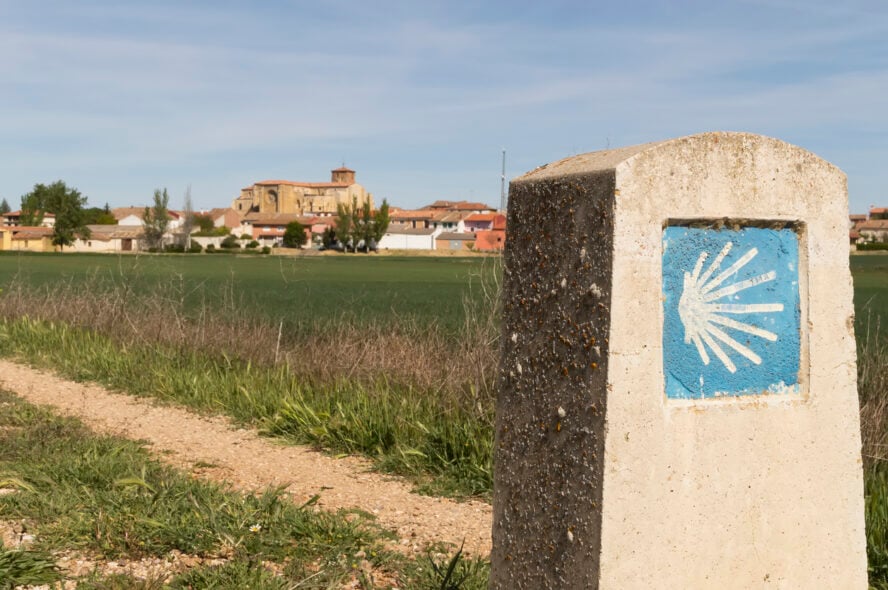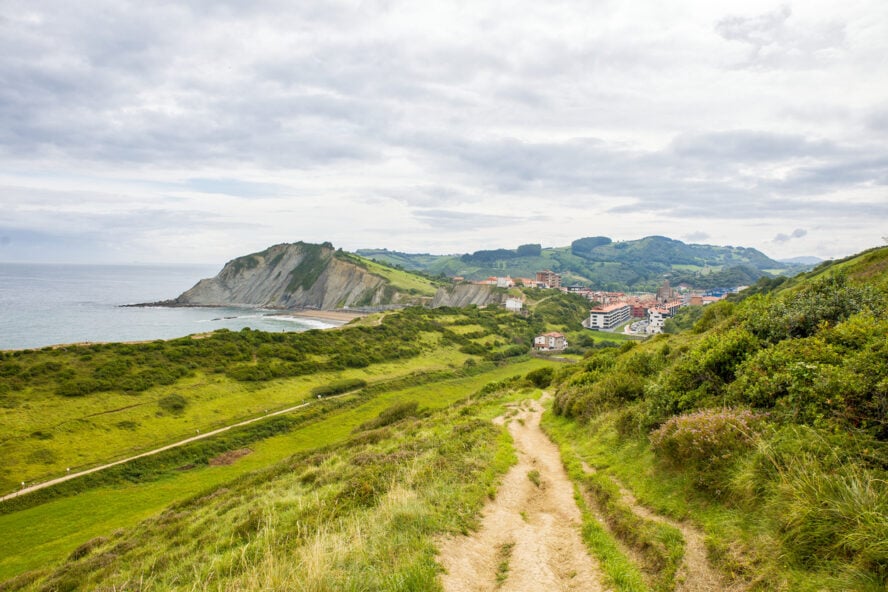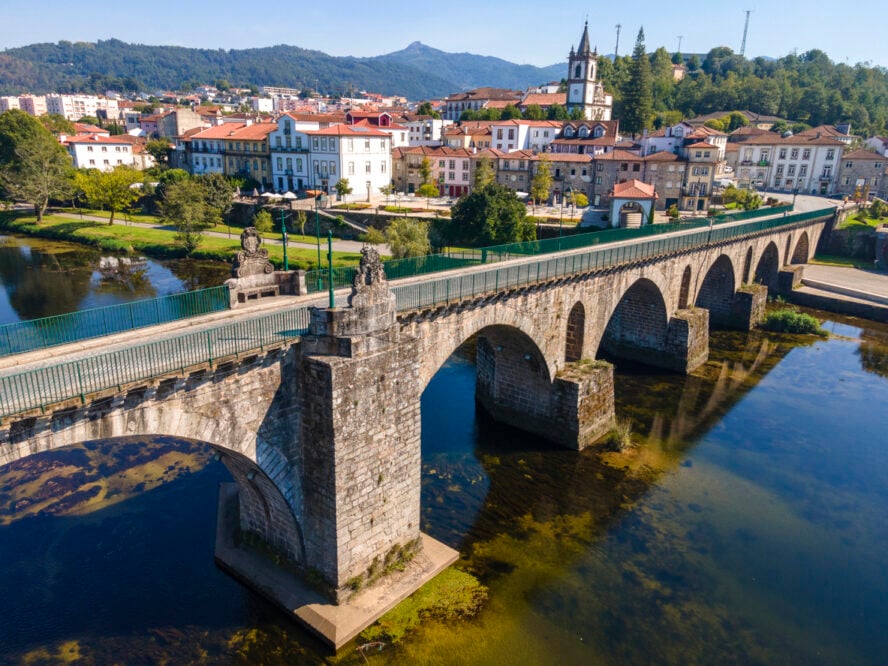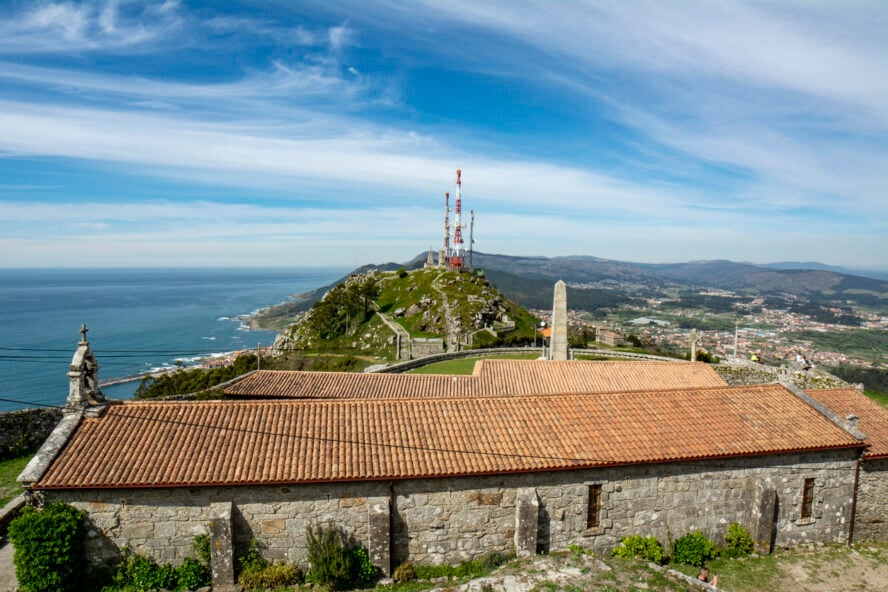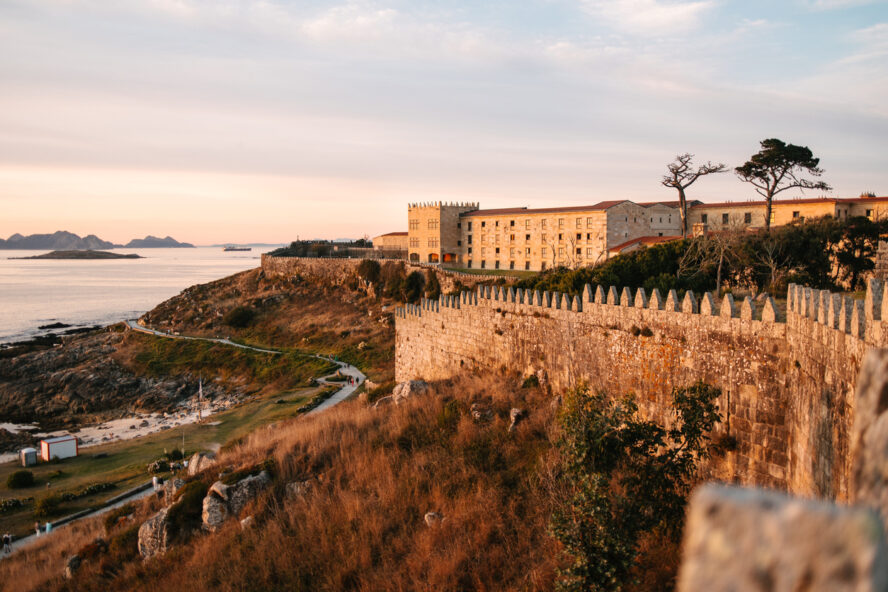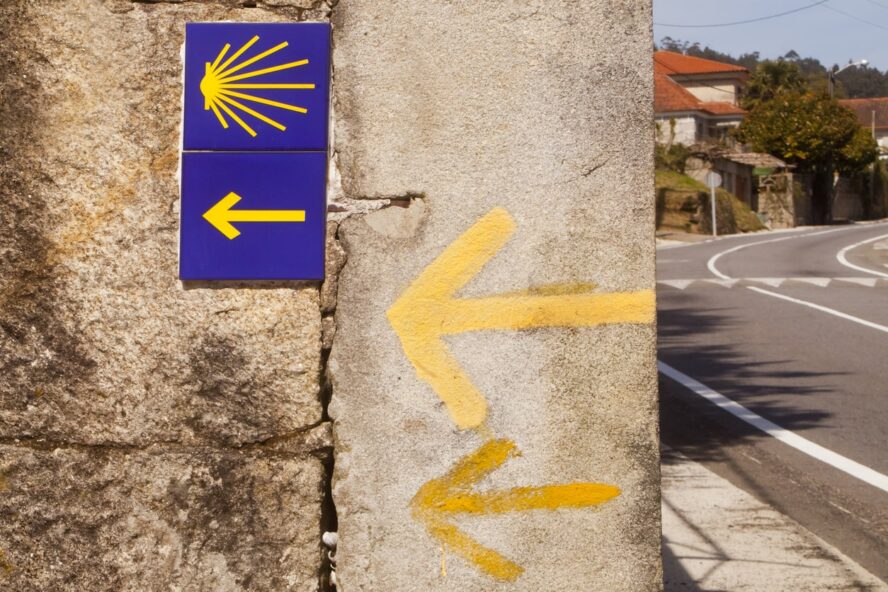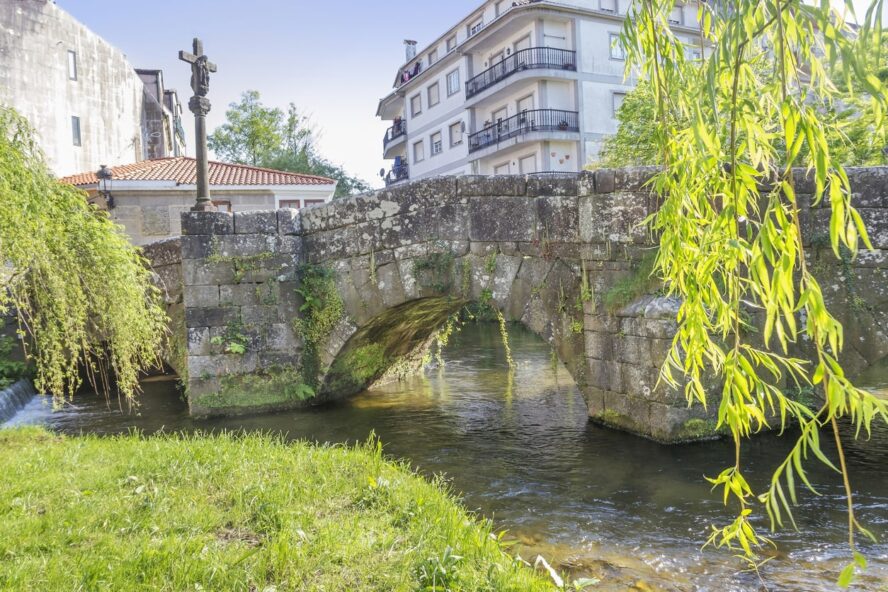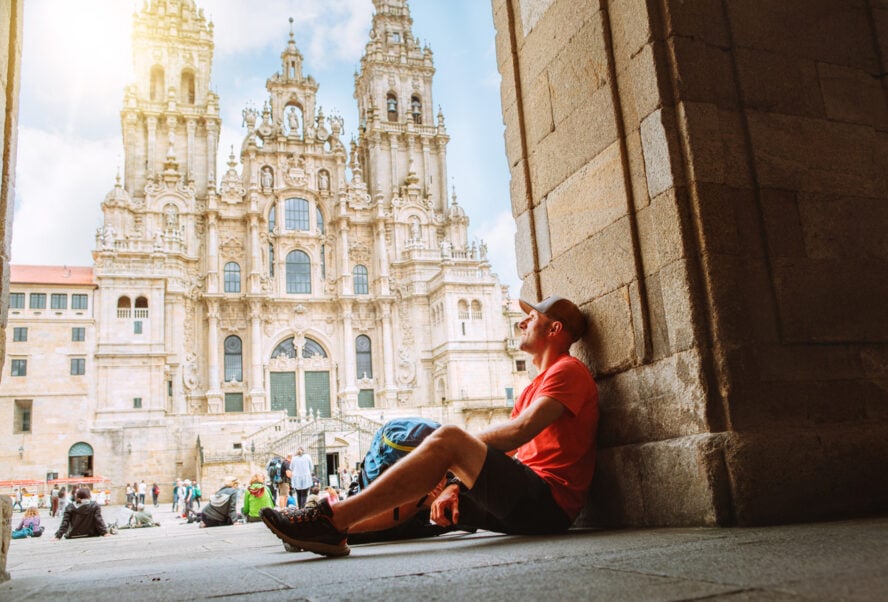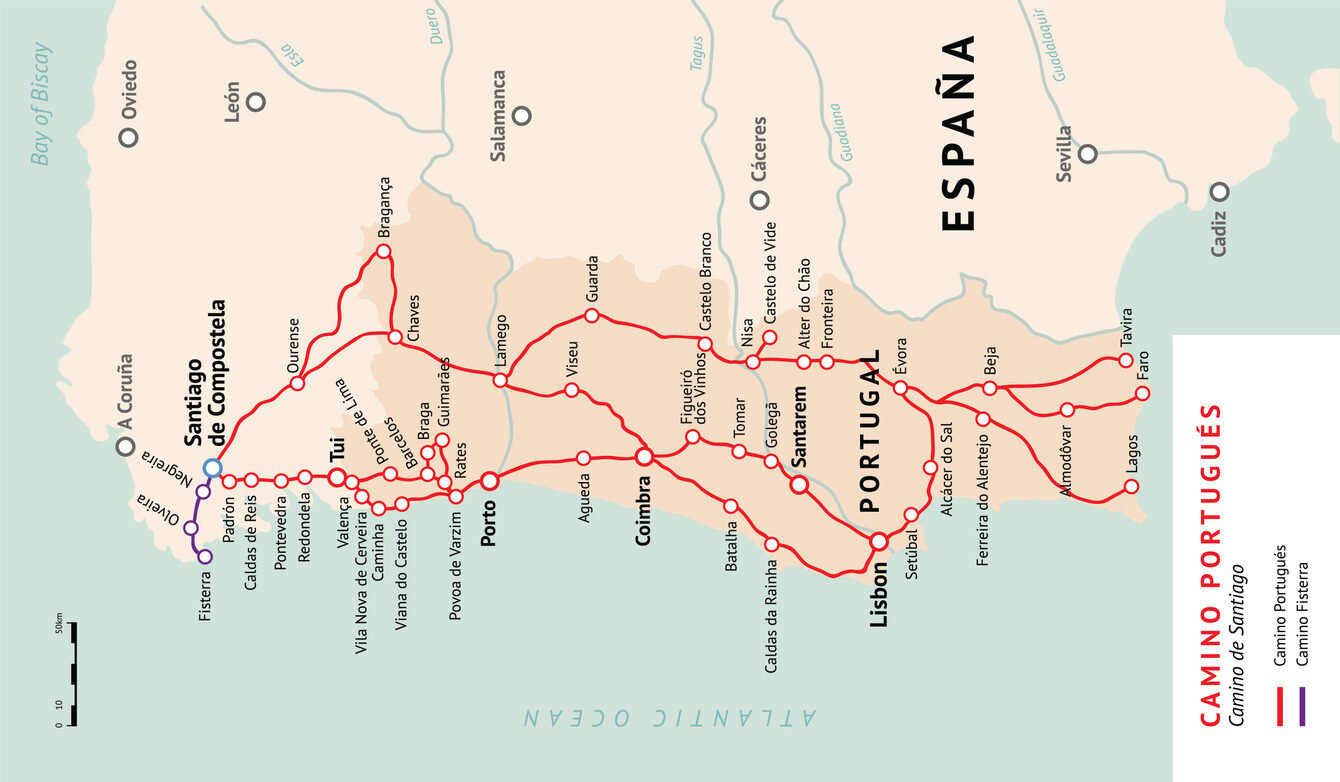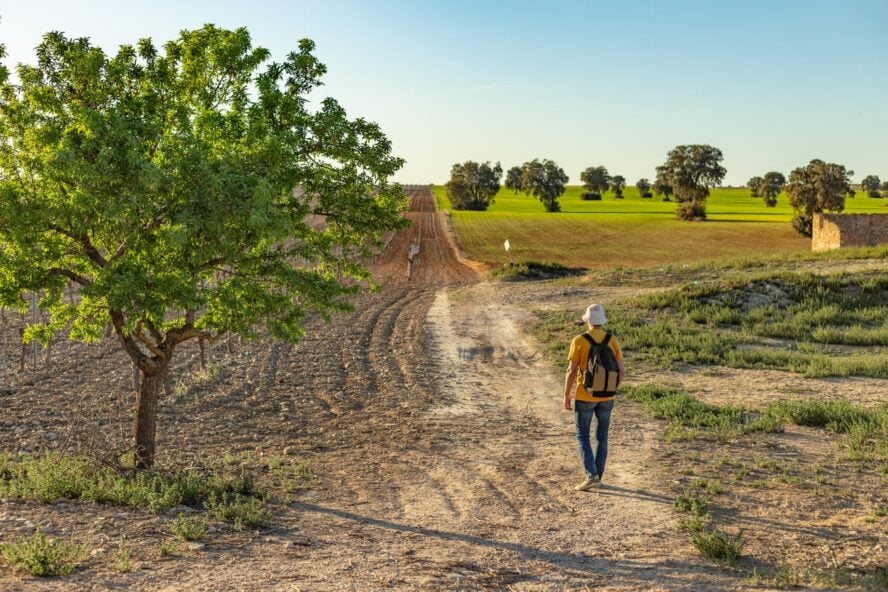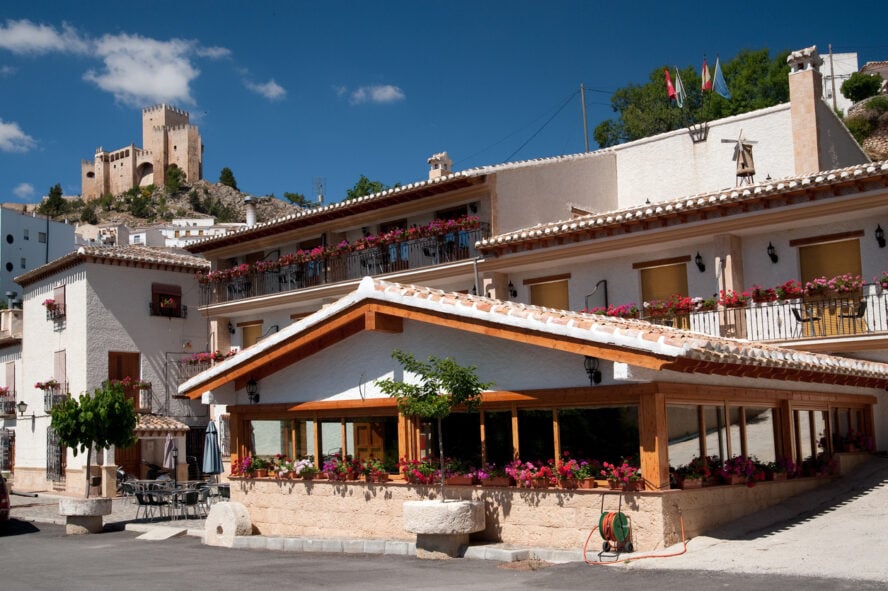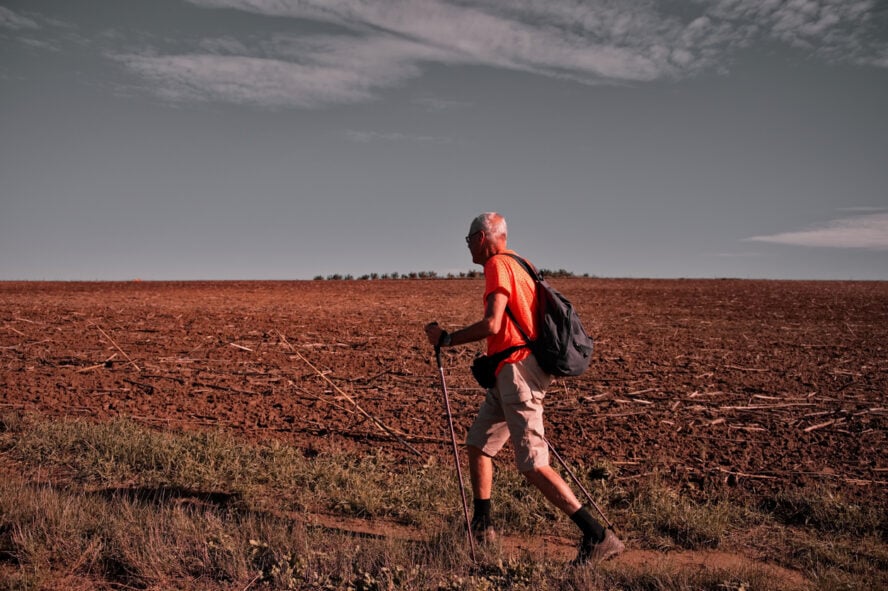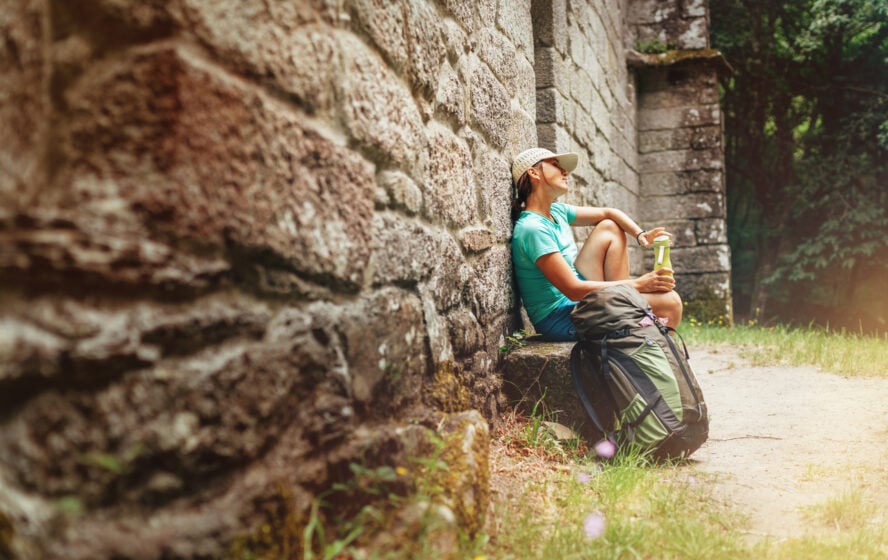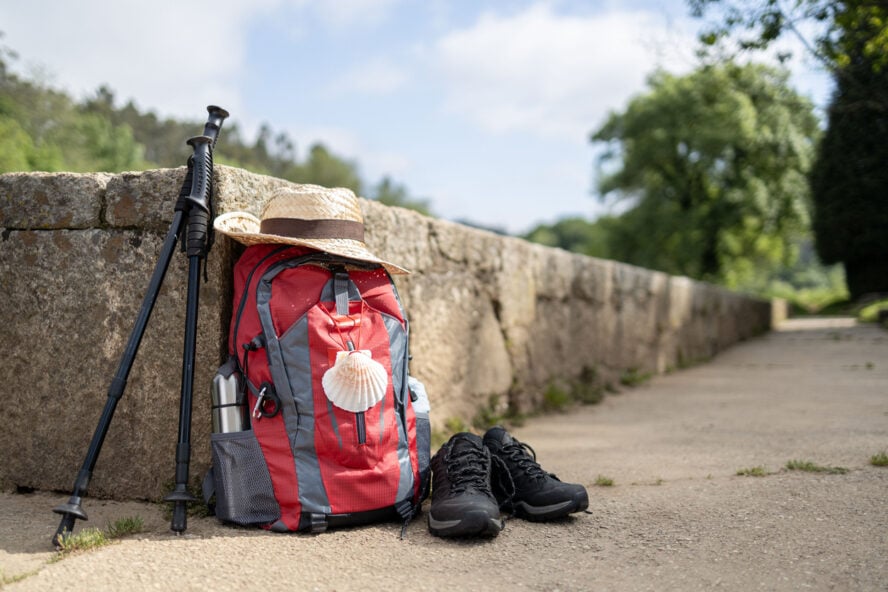Every great pilgrimage has its poetry, and the Camino Portuguese Coastal Route might be the most lyrical of them all.
Stretching along the rugged Atlantic from Porto, Portugal, to Santiago de Compostela in Spain, this route follows a line where ocean meets land, where the scent of salt mingles with eucalyptus, and where every step carries a whisper of centuries-old faith and exploration.
What Is the Camino Portuguese Coastal Route?
Unlike the more famous Camino Francés, which cuts inland across Spain, the Camino Portugués da Costa (as it’s known locally) is something entirely different: a blend of seafaring culture, quiet fishing villages, and vast coastal views that make each day a moving meditation on water, wind, and wandering.
Pilgrims and hikers walk for all kinds of reasons: spiritual renewal, adventure, reflection, or simply the joy of long-distance travel. The Camino Portuguese Coastal Route offers the perfect canvas for all of them.
The trail follows ancient maritime trade paths and Roman roads, many of which once carried pilgrims heading north toward Santiago. It’s less crowded than the inland Portuguese route, but still well-marked, safe, and rich with the warmth of local hospitality.
Imagine dawn breaking over Porto’s tiled rooftops, the Atlantic shimmering gold beyond the Douro River. You sling on your backpack, step past a waymarker bearing the yellow scallop shell, and just like that, your pilgrimage begins.
Who Is the Camino Portuguese Coastal Route For?
The Coastal Route attracts a wonderfully mixed crowd: hikers, pilgrims, and travelers who crave the rhythm of the sea.
If you love coastal landscapes, seafood, and smaller towns, the route is for you. It’s ideal for:
-
First-time pilgrims who want a more relaxed, scenic introduction to the Camino.
-
Hikers seeking a long-distance walk that balances wilderness and comfort.
-
Solo travelers, because the route is safe, social, and easy to navigate.
-
Culture crawlers drawn to Portugal’s seaside life and Spain’s Galician heritage.
Compared to the busier Camino Francés and many other Camino de Santiago routes, this route offers more solitude, fewer crowds, and stunning ocean views, complemented by excellent infrastructure.
How Long Is the Camino Portuguese Coastal Route?
The full Camino Portuguese Coastal Route covers roughly 280 kilometers (174 miles) from Porto to Santiago de Compostela, depending on which variations you follow.
Along the way, you’ll cross two countries, dozens of historic villages, and countless beaches where you can dip your feet after a long day’s walk.
How Much Time Does It Take to Walk the Route?
Most hikers complete the route in 12–14 days, averaging 20–25 kilometers (12–15 miles) per day.
Many pilgrims who want to take it slow add extra rest days in seaside towns like Viana do Castelo, Baiona, or Vigo.
If you have less time, you can start from Vigo or Baiona in Spain, covering the final 100 kilometers required to earn the official Compostela certificate.
Where Does the Route Start & End?
The classic starting point is Porto, Portugal’s second-largest city and a UNESCO World Heritage Site known for its blue azulejos, Douro River bridges, and port wine cellars.
From there, the route follows the coastline north through Vila do Conde, Viana do Castelo, and Caminha, crosses the Minho River into Spain at A Guarda, and continues through Baiona, Vigo, Redondela, and Pontevedra, before arriving in Santiago de Compostela.
Many hikers choose to spend a night in Porto before starting, exploring its riverside neighborhoods and gathering their first Camino stamp at the Sé Cathedral, the traditional starting point.
The Main Camino Portuguese Coastal Route
The main route, often called the “Senda Litoral” or official Coastal Camino, hugs the ocean for much of its length. You’ll spend your mornings walking along boardwalks and sandy paths, your afternoons crossing estuaries or inland stretches, and your evenings dining in seaside towns.
The terrain is gentle, and waymarking is excellent. Yellow arrows and scallop shells lead the way at every junction. The route merges with the inland Portuguese route near Redondela, before the final approach to Santiago.
Keep in mind that this section (the Redondela to Santiago stretch) is busier, as both inland and coastal pilgrims converge here.
Some Good Variations to Consider
There are several popular variations of the Camino Portuguese Coastal Route, each with its own charm:
1. Senda Litoral (Littoral Way)
This is the truest “by the sea” route. It follows boardwalks, promenades, and beaches almost the entire way between Porto and Vigo. It’s slightly longer and more exposed to wind, but endlessly scenic.
2. Coastal + Central Combination
Some hikers walk the coast until Viana do Castelo or Caminha, then head inland to join the Central Route early. This offers a mix of coastal and countryside walking.
3. The Spiritual Variant
From Pontevedra, you can take the Variante Espiritual, a stunning detour through forests and fishing villages to Vilanova de Arousa, where a boat ferry retraces the legendary final journey of Saint James’ remains up the Ulla River to Padrón. It’s the most atmospheric way to finish the Camino.
4. Northern Portugal Extension
Ambitious walkers can start even earlier — from Lisbon or Coimbra — and join the Coastal Route in Porto. This turns your pilgrimage into a month-long odyssey through Portugal’s heartland.
Camino Portuguese Coastal Route Stages
The Camino Portuguese Coastal Route unfolds like a slow travel dream. It’s a string of seaside towns, pine-scented boardwalks, and ancient waymarkers guiding you north with the Atlantic always just to your left. Most hikers take 12 to 14 days to complete the journey from Porto to Santiago, covering around 20–25 kilometers a day.
Here’s what that pilgrimage actually feels like, step by step.
Stage 1: Porto to Vila do Conde (33 km / 20 mi)
Your pilgrimage begins in Porto, one of Europe’s most atmospheric cities. After collecting your first Camino stamp at the Sé Cathedral, you’ll leave behind the tiled façades and port wine cellars, following the Douro River until it meets the Atlantic at Foz do Douro. From there, the ocean becomes your compass.
You’ll walk long stretches of wooden boardwalk through dunes and beaches, pass small fishing harbors in Matosinhos, and feel the hum of the sea beneath your feet. By the time you reach Vila do Conde, a charming riverside town with a monastery and old aqueduct, you’ll already feel the rhythm of the Camino settle in.
Stage 2: Vila do Conde to Esposende (25 km / 15.5 mi)
Leaving Vila do Conde, the path hugs the coast past sleepy beach towns and wide sandy shores. This section feels peaceful; long, open horizons, gentle sea breezes, and the occasional beach café for espresso and pastries.
You’ll cross small estuaries and wooden bridges before arriving in Esposende, a pretty town set where the Cávado River meets the Atlantic. Many walkers pause here to enjoy a seafood dinner or sunset stroll along the promenade.
Stage 3: Esposende to Viana do Castelo (25 km / 15.5 mi)
This stage combines forest and coast in perfect measure.
The trail weaves through pine groves, farm tracks, and occasional beachside boardwalks. You’ll pass windmills, old chapels, and long stretches of solitude before reaching the iconic iron bridge designed by Eiffel himself, leading you across the Lima River into Viana do Castelo.
It’s one of Portugal’s most beautiful towns: colorful streets, a hilltop basilica overlooking the sea, and plenty of cozy guesthouses to rest your feet.
Stage 4: Viana do Castelo to Caminha (29 km / 18 mi)
The coastline north of Viana is wild and open. Sea spray, sand dunes, and small fishing villages that feel unchanged for generations. The landscape begins to shift; greener, hillier, and tinged with the feeling that Spain is near.
Your day ends in Caminha, a picturesque border town where Portugal meets Spain. Pilgrims gather on the riverbank at sunset, watching the ferry drift across the Minho. Your gateway to Galicia.
Stage 5: Caminha to A Guarda (Spain)
The morning ferry across the Minho River is one of the Camino’s small, joyful rituals. It’s a symbolic crossing. One country to another, one chapter to the next.
Once in A Guarda, you’ll feel the cultural shift immediately: Galician language, tapas bars, and granite houses. The climb to Monte Santa Tegra rewards you with sweeping views over the Atlantic and ancient Celtic ruins scattered across the hillside.
Stage 6: A Guarda to Oia (13 km / 8 mi)
This is one of the most tranquil days of the entire route, a gentle amble along rugged sea cliffs and quiet coves. The path meanders past fields and lighthouses until the Monastery of Oia comes into view, a hauntingly beautiful 12th-century structure right on the shoreline.
Many walkers choose to spend the night here, lulled to sleep by the sound of waves crashing against ancient stone.
Stage 7: Oia to Baiona (18 km / 11 mi)
From Oia, the trail bends inland slightly before rejoining the coast. Small villages appear between rolling hills and open sea views, and cafés dot the way — perfect for morning coffee breaks.
Baiona greets you with palm-lined promenades and a cheerful harbor. It’s here that news of the New World first reached Europe in 1493, carried by one of Columbus’ ships. Today, it’s a lively seaside town with excellent seafood restaurants and golden beaches to rest your legs.
Stage 8: Baiona to Vigo (23 km / 14 mi)
This stage brings you closer to urban Galicia. You’ll walk a mix of paved paths and seaside promenades as you approach Vigo, the largest city on the route.
It’s busier than the quiet coastal villages before it, but Vigo has its charms: fresh oysters along the harbor, lively bars, and comfortable modern hotels. It’s also a good place to take a rest day or resupply before heading inland.
Stage 9: Vigo to Redondela (16 km / 10 mi)
Leaving Vigo, the Camino climbs gently through eucalyptus forests, with occasional glimpses back over the Ría de Vigo bay. The terrain becomes more rural again, with farms, stone hamlets, and shaded woodland paths.
In Redondela, the Camino Portuguese Coastal Route merges with the Central Route, so you’ll notice a livelier energy as pilgrims from inland Portugal join the flow toward Santiago.
Stage 10: Redondela to Pontevedra (19 km / 12 mi)
This stage winds through tranquil countryside dotted with vineyards and stone churches. The route crosses ancient Roman bridges and follows shaded forest tracks, always a welcome change from the coastal winds.
Pontevedra is a cultural gem: car-free old town, elegant squares, and delicious Galician cuisine. Many hikers spend an extra night here to explore and recharge.
Stage 11: Pontevedra to Caldas de Reis (22 km / 13.5 mi)
Now deep in Galicia’s heartland, you’ll leave the coast behind and walk through farmland, quiet lanes, and small vineyards. The atmosphere becomes contemplative. More rural, more timeless.
Your reward at the end of the day? The thermal springs of Caldas de Reis, famous since Roman times. Soak your feet in the warm public fountains. It’s practically a pilgrim’s rite of passage.
Stage 12: Caldas de Reis to Padrón (19 km / 12 mi)
The trail continues through forested paths and across gentle rivers. You’ll sense the anticipation building. Santiago is close!
In Padrón, you reach a place steeped in legend. According to tradition, it was here that the boat carrying the remains of Saint James first arrived from Jerusalem. Today, it’s a town of stone arcades, flower-filled plazas, and, of course, the famous Padrón peppers: small, green, and occasionally fiery.
Stage 13: Padrón to Santiago de Compostela (25 km / 15.5 mi)
Your final day begins in the soft Galician mist and ends beneath the spires of Santiago de Compostela’s Cathedral, the emotional climax of every Camino. The last kilometers roll gently through forests and villages before giving way to cobblestone streets and the crescendo of church bells.
Reaching the Praza do Obradoiro is a moment that stays with you forever. Equal parts triumph, gratitude, and disbelief that the journey is done.
Take your time here. Sit on the stones, watch other pilgrims arrive, and let the feeling sink in. You’ve walked the Camino Portuguese Coastal Route, one of the most beautiful routes to Santiago, and the Atlantic still hums somewhere inside you.
Camino Portuguese Coastal Route Map
The Camino Portuguese Coastal Route map traces a graceful curve north along Portugal’s western edge, cutting inland just before Redondela.
It’s the only Camino that follows the sea so faithfully. It’s a constant companion right up until Galicia’s green hills pull you inland toward Santiago.
Frequently Asked Questions About the Camino Portuguese Coastal Route
What’s the Best Time to Hike the Camino Portuguese Coastal Route?
The best months are May through October. May – June and September – October are ideal. You’ll enjoy long daylight hours, mild temperatures (18–25°C / 65–77°F), and fewer crowds.
July and August will have warmer weather and busier beaches, especially near Porto and Baiona. If you go in spring, you’ll encounter lush greenery and wildflowers; in autumn, golden light and quiet trails.
Winter is possible, as temperatures rarely drop below 10°C (50°F), but storms and closed accommodations make it more challenging.
How Difficult Is the Route? Can Beginner Hikers Do It?
The Camino Portuguese Coastal Route is one of the most beginner-friendly Caminos.
The path is mostly flat with gentle rolling hills, well-marked waypoints, and easy access to towns. Daily distances (20–25 km) are manageable for anyone with basic fitness and comfortable shoes.
If you’re new to long-distance walking, train by walking 8–10 miles several times a week beforehand. The terrain is forgiving, but endurance comes from consistency.
Where Should I Stay Along the Route?
Accommodation is one of the Camino’s joys. There’s something for every traveler.
-
Albergues (Pilgrim hostels): Budget-friendly, social, and traditional. You’ll share dorms and swap stories over communal dinners.
-
Pensões and Guesthouses: Mid-range private rooms with warm hospitality.
-
Hotels and Boutique Inns: Coastal towns like Baiona and Viana do Castelo offer charming boutique stays.
-
Rural Casas and Refugios: Converted farmhouses or stone cottages with real character.
Plan ahead in July and August, as the route is busier. Booking 1–2 days in advance is plenty outside peak months.
What Will I Eat?
If food is part of your motivation (and let’s be honest, it should be), you won’t be disappointed.
In Portugal, you’ll eat plenty of fresh seafood like grilled sardines, octopus salad, and bacalhau (salt cod). Make sure to wash it down with vinho verde, the region’s crisp “green wine.”
Crossing into Spain, Galicia greets you with hearty seafood stews, pulpo a la gallega (octopus with paprika), and rustic empanadas. For dessert, nothing beats Tarta de Santiago, the almond cake that marks your arrival in the holy city.
Cafés and bakeries are frequent. You’ll never go hungry, and every town celebrates its own specialties.
How Safe Is the Camino Portuguese Coastal Route?
It’s extremely safe.
Both Portugal and Spain rank among the safest countries in Europe, and Camino culture is built on respect and community. Solo travelers, including women, regularly walk the route without issue.
That said, use basic common sense: don’t leave valuables unattended, and wear reflective gear if you’re walking early or late. The main hazards are sun exposure, blisters, and overexcitement ordering wine at lunch.
Can I Bike the Route Instead of Hiking It?
Yes, and it’s spectacular by bike.
Due to its gentle grades, seaside roads, and well-maintained paths, the Camino Portuguese Coastal Route is perfect for cycle touring. Mountain or gravel bikes are best, as some stretches include cobbles, sand, or boardwalks.
Cyclists usually cover the route in 4–6 days, depending on pace. Most albergues accept cyclists, though a few prioritize walkers. Bike rental is easy in Porto, and luggage transport services can lighten the load if needed.
What to Pack for the Camino Coastal Route
Packing for the Camino is an art of subtraction. The golden rule: your backpack should weigh no more than 10% of your body weight.
Camino Portuguese Coastal Route packing list
-
Lightweight hiking shoes or trail runners (well broken in)
-
2–3 moisture-wicking shirts
-
2 pairs of hiking socks
-
1 fleece or light down jacket
-
Waterproof shell jacket
-
Convertible hiking pants or leggings
-
Quick-dry towel
-
Hat, sunglasses, and sunscreen
-
Refillable water bottle (tap water is safe everywhere)
-
Basic first-aid kit + blister care
-
Guidebook or smartphone with offline maps (Wise Pilgrim app recommended)
-
Pilgrim Credential (Credencial del Peregrino): You’ll need this to collect stamps and receive your Compostela certificate in Santiago.
Optional but handy: trekking poles, a sarong or lightweight travel sheet, and a small lock for hostel lockers.
The Camino Portuguese Coastal Route Will Change Your Life
Walking the Camino Portuguese Coastal Route isn’t just about reaching Santiago.
It’s the sound of waves crashing as you step onto the boardwalk each morning. The warmth of a seaside village café after miles on the trail. The rhythm of your own footsteps blending with centuries of pilgrims who’ve walked this way before.
The route offers a perfect balance of challenge and serenity. The Atlantic will guide you north, the yellow arrows will keep you on course, and somewhere between Porto and Santiago, you’ll find what every traveler eventually does: that the destination was never really the point.
So lace up your boots. Fill your shell with sand and stories. And start walking north. The coast is calling.

